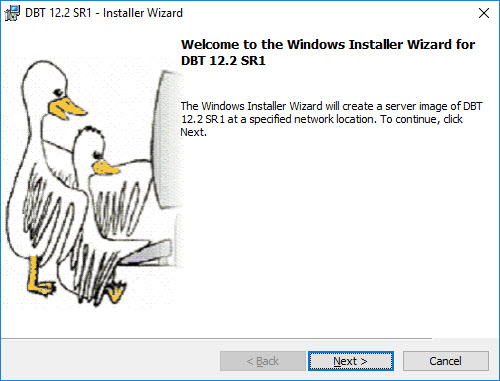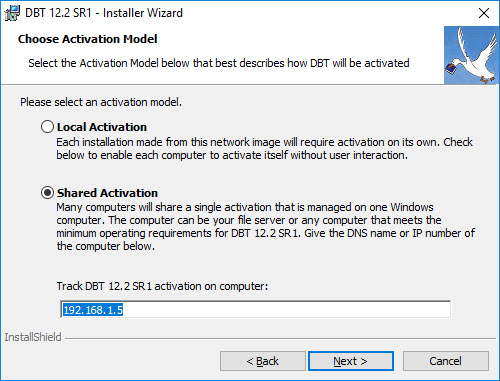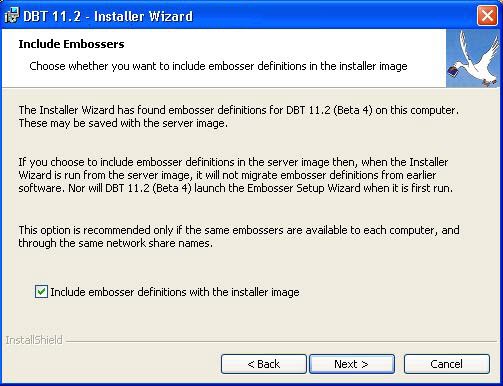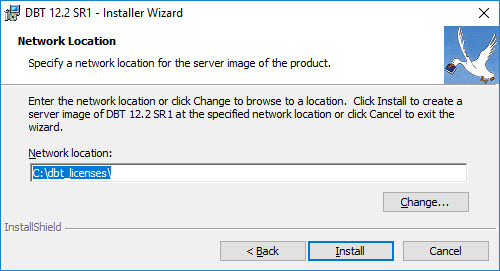Network Installation Using a Server Image (Automatic Client Deployment)
Acquiring a multi-user license for your Duxbury program enables you to run your own network-based installation. A network-based installation allows all the instances of DBT or NimPro, on as many machines as they are installed, to be activated through a single server machine on your local area network. Only the server computer needs to be activated; all other users on the network become activated as its clients. Naturally, the server must be activated for a sufficient number of users to serve your intended number of client machines, and the server must be up and running at all times.
Note: Below, a word or abbreviation inside angle brackets, like <Enter> or <Esc>, indicates a specific key on your keyboard.
For this method of installation, you create a specialized installer package that we refer to as a server image. To use it, you must place the server image in a network location accessible by the client machines where you intend to install DBT, or you must copy it to the individual client machines.
If either creating the server image or mounting the image on your network is inappropriate for any reason, you should use the manual approach instead. See Network Installation using the Activation Wizard.
Overview
Network installation with automatic deployment consists of these steps:
- Assemble the information and tools to create the server image.
- Install DBT on the server or master workstation.
- Activate DBT for multiple users on the server.
- Configure embossers in DBT on the server.
- Install the Shared License Service and allow it in the firewall.
- Create the server image of the DBT installer. Save the server image in a shared folder that client computers can access.
- On each client machine, install DBT from the server image.
Now we go through these steps in detail.
(1) Assemble the Information and Tools
- First, whether you downloaded your program (DBT or NimPro) directly from Duxbury, or from your dealer, or you received it on a CD, you need to know the location of your program's installer, that is, the volume and folder path where the installer .msi file is located on your computer.
- Second, you need to know the location of the Shared License Service installer. This is a separate installer which is also on the distribution CD, or it can be downloaded from Duxbury from one of a couple of locations, www.duxburysystems.com/downloads/duxsls-0100.msi or www.duxburysystems.org/downloads/duxsls-0100.msi. (Notes: First, the default security settings on some recent versions of the Windows operating system can make this operation difficult and (worse) throw misleading error messages in the process; you may need to copy the URL to an external browser to download this installer. Second, the revision number of this installer file may change over time. Third, if you use NimPro with DBT, a single Shared License Service handles both programs.)
- Whether you are installing DBT, NimPro, or both at the same time, for each program you need your license text and you need to know the maximum number of users you are licensed for. The number of users should be found on your purchase paperwork, emails, or other key documents relating to your installation.
- You should verify that TCP/IP port 8080 is not already in use on your network and will not be blocked by internal firewalls between the machines where DBT and NimPro will be installed. This is the default port number that the Shared License Service uses. If port 8080 is not available or not suitable, then choose another port and pay close attention to the instructions about where to enter your custom port number.
- You need your server’s DNS name in order to locate it from the client machines. If your server does not have a DNS name, you can instead use the server’s IP address as long as it is a static IP number (i.e. not dynamically assigned and therefore changeable over time). On the server, use
ipconfig /all <Enter>to find out its DNS name. You can useping server-name <Enter>on the client machines to verify that the client machines can locate the server with that name. (In this example, replace “server-name” with the actual name of your server machine.) Note: Do not use a dynamic IP address, or your client machines will only work until the next time the server is rebooted!
- If you intend to share one or more braille embossers with all the DBT users on the network, you should have any documentation you need to define a global embosser configuration for each one that is to be shared.
- You must prepare a network location (shared volume) to make available the server image you will create. There should be at least 100 MB free at this location. This location must be writable for you, and it must be readable from all the computers where DBT will be installed. Do not use the “Program Files (x86)”, “Program Files,” or “Windows” directories. Use a new directory with nothing else in it. The location you share from need not be on your DBT server computer. For example, let us say that you have set up a directory on "server10" called "DBTinstall". The network location of the server image would be “\\server10\DBTinstall.”
(2) Install DBT on the Server or Master Workstation
We say, server or master workstation, because the computer you choose as the master for DBT/NimPro activation need not be running a server operating system. This gives you a wider choice of computers to use as your master for activation. If your computer is not a Windows Server machine, then it must be at least a Windows 10 computer or later, and you need to be willing to leave it running whenever DBT/NimPro is needed by any user on the network.
Note: Duxbury programs work on Windows 7 computers, but that operating system is no longer supported by Microsoft.
Once you have chosen a server machine, install DBT/NimPro on it by following the Single-User (Simple) Installation instructions.
(3) Activate DBT on the Server
The next step is to activate DBT/NimPro on the server machine. (If installing both programs, you need to activate each one separately, DBT first.)
When you launch DBT, you will see an Activate button on the splash screen. Click that, or the like button in the About DBT dialog, to invoke the Activation Wizard.
In the case of NimPro, look for the Activation Wizard menu item under the Help menu.
The Activation Wizard can also be run directly from your Duxbury program's home folder (look for actwiz.exe).
On the Activation Wizard main page find the radio button labeled, Set up this server to host the network license. Select that and click the Next button.
From there, you simply follow the instructions in the wizard, but here are some helpful hints.
- Activate by Internet if you can. It is by far the quickest and most convenient method.
- If you are not using port 8080, the wizard will show you where to enter your selected custom port number.
- You will need your license text, the server computer name, and a user name. The license text may be pre-populated for you.
- To avoid confusion we strongly recommend you enter the same computer name as the DNS name that client machines will use to address this server.
- In the User Name field, you may want to enter the name of the organization (perhaps abbreviated) or the name of the license owner. This is the name that will be associated with your Duxbury program activation. Keep track of it to enter the same name again from all of the client machines.
Note: This is the only activation you should do for your Duxbury program. Do not activate the individual client machines. Instead they will each initiate connection to your server using the Activation Wizard "Connect" function.
(4) Configure Global Embossers on the Server
Now that the server is activated for DBT, you may configure the embossers that you wish to support for all DBT installations on your network.
To create global embosser configurations, your DBT must be running with administrative privileges. Start DBT by right clicking on the DBT icon and select Run as administrator. Then, at the User Account Control (UAC) prompt, enter the admin password if needed.
In the DBT menu bar, open the Global menu and select Embosser Set-up. Use the New button in the dialogue box to define new embossers (or use Modify Embosser to revise existing definitions). Enter all the settings your embosser requires, and on the General tab you must set the value of Configuration Location to “All users on this computer.” You must do this explicitly to share the embosser definition; this is not the default setting.
At this time, only configure the embossers that you intend to share with all the DBT client machines.
(5) Install the Shared License Service
Summary: Just the same way most Duxbury programs are installed from an installer package (an .msi file), you install the Shared License Service from its installer, duxsls-0100.msi, which you can download from https://www.duxburysystems.com/downloads/duxsls-0100.msi. (Note: the version number is subject to change.) When you complete the installation, the network license-sharing service starts up. This service allows other machines on the network to obtain their activations from your server.
The Installer: The installer guides you through each step, beginning with the End User License Agreement, which you must accept to enable the Next button, and which we recommend you read through at least once. By default the installer places the Shared License Service files in the "Duxbury \ Shared License Server" folder. We recommend you accept the default location.
On the last page of the installer, the Install button completes the installation using the selected folder. If your version of the installer includes a check box prompting you to “Configure and start service” you should leave that item checked, because it will open the Duxbury SLS Editor for you automatically. If not, you need to go to your selected installation folder (again, the default is "Duxbury \ Shared License Server") and click on the DuxSlsEditor.exe to run it.
The Editor: If your installation includes multiple versions of DBT, or includes the combination of DBT and NimPro, or uses third-party software that is activated using Sheriff, you need to configure them to work in concert through the SLS Editor. Even if you have no complications, you still invoke the Editor in order to build the required initialization files and to start the service.
The Editor prompts you for a port number for the Shared License Service. As previously noted the default is port 8080, and you can use that if it is not already in use or unsuitable for some reason local to your own network. If you entered a different port number in the Activation Wizard, enter that same port number here.
On this same screen, the Editor provides a list of check boxes where you indicate which Duxbury products you wish to share from this server. In the most common case, that list contains only a single version of DBT that you have just installed and activated, or the combination of DBT and NimPro. In the most complicated case, the list may include several Duxbury products and versions, or even third-party software.
Unless necessary, we do not recommend running third-party products (should any be listed) under the same port number as your Duxbury applications. In the most complex case, conflicts between Duxbury and third-party software may possibly be resolved by editing the content of the initialization (.ini) files per the next screen in the Editor. Consult your local IT personnel if you need to do this. Normally no editing of these settings is required.
On leaving the Editor you must click the Start Service button to launch the Duxbury Shared License Service. You can confirm this service is running by finding it under this name in your Services control panel. That is variously found under Administrative Tools or Computer Management (or elsewhere) depending on your Windows OS version.
Concerning Your Firewall
The Duxbury Shared License Service is not added to the list of rules (or programs) in your firewall automatically. To add it you must edit the Inbound Rules of the Windows Firewall (or a similar list of allowed programs if using a third-party firewall).
Using the Firewall in Windows 10 as an example:
In the Windows Firewall, you need to access the Advanced Settings (administrative level) functions.
To avoid confusion, we suggest you name the new entry, “Duxbury Shared License Service.”
Assuming you have installed the Shared License Service in the normal location, the program you need to allow is under the “Duxbury \ Shared License Server” folder. The program you need to allow is named “slsServer.exe”.
Once you create the new entry, you can open the specific port number through which this service communicates. In the Windows Firewall this setting is found under the Properties of the Duxbury Shared License Service.
Consult your specific firewall documentation for additional guidance.
(6) Create the Server Image of the DBT Installer
All the preceding steps have been done on your DBT server machine. This step must be done there as well, because this is the only way to include global embosser definitions in the server image that you will use to install your clients. At the end of this procedure, you place the server image in an empty destination folder either on the DBT server or another network location.
Note: The destination folder must be a writable shared volume and accessible by your client computers.
To create your server image:
-
From a command prompt window, open the DBT installer by invoking the Windows msiexec.exe program with the “/a” switch and the path to the installer. If you are installing from a Duxbury CD on your D: volume, for example, the command line is:
msiexec /a D:\dbt-1205.msi <Enter>
- Click Next, or type <Alt>+N, to dismiss the Welcome Screen. (It is similar to the first screen in the Simple Installation instructions, but the text shows that you are creating a server image.)
- Please, read the End User License Agreement (EULA) if you haven't read it before. You must agree to the terms of the EULA to proceed. Click Cancel or type <Esc> if you do not agree to the terms. Otherwise, type <Alt>+A to accept the agreement and <Alt>+N to proceed. (The screen described in this step is exactly the same as in the Simple Installation instructions.)
- You now see the Customer Information Screen, the same as the third screen in the Simple Installation instructions. You enter information in this screen just as if you were doing a typical install, but bear in mind that the information will be stored in the server image for use in the DBT clients. When you install from the server image, this information will be preset for you. You must enter your Duxbury License Text. We recommend that you enter your Organization name. For the User Name field, enter the name you want to have associated with your activation. This might be a reference to your organization (“Xxx School f/t Blind”), the name of the license owner, or even a generic user description such as "Xxx Sch. Dist. Transcriber" as befits your situation. Click Next, or type <Alt>+N, to continue.
-
The next screen, Choose Activation Model, is unlike anything in the Simple Installation. It looks like this:

When this dialogue opens Local Activation is selected. Change the selection to Shared Activation (push the down-arrow key or click on the second radio button). Shared Activation is the required option for sharing DBT activations over the network. Now use the Tab key to reach the text field labeled Track DBT activation on computer and type the DNS name or IP address of the server that you just activated. Click <Alt>+N to continue.
Notes: First, you can only use an IP address if it was assigned to the server as a static IP number. Second, if you are using a port other than 8080, you must add a colon and the port number to the contents of this field. For example, for a computer named “Server6” using port 8010 you might enter "Server6.mydomain.com:8010".
-
If, as described earlier, you have used DBT – on this computer – to configure at least one braille embosser for “All users on this computer,” the installer now displays the Include Embossers screen:

If you do not see this screen, no embosser configurations will be included in your server image!
If you intended to include global embosser configurations in your server image but do not see this screen, you must click Cancel (or press <Esc>) and start the process over after you have created them. Remember that they must be created on this machine, and the location must be set to "All Users on this computer." Only the configurations for all users are included in the server image.
If, on the other hand, you do see this screen, but do not want to include embosser definitions in the server image, simply uncheck the check box or type <Alt>+I, to remove the check mark. Then click Next, or type <Alt>+N, to continue.
-
Next, the installer displays the Network Location screen:

You must provide the network path (shared volume) where you want the server image created. Remember that the server image destination must be an empty folder where you have write access. For example, given a server named “server10” and a location found at the simple path “DBTinstall\new,” you would enter “\\server10\DBTinstall\new” in this field. You can also use the Change button to browse for the destination path you have prepared.
Note: The installer will create the destination path if it does not already exist. In the process it will create or overwrite directories within that path as necessary.
Click Install, or type <Alt>+I, to begin creating your server image.
- The installer next displays a dialogue with a progress bar and a Cancel button, and eventually it displays “Completed”. Click the Finish button, or type <Alt>+F, and your server image is ready for use.
(7) Install DBT on each Client Machine from the Server Image
After you have created the server image in a network accessible location, use it to install DBT on each client computer. From the client machine, double click on the server image, and follow the instructions. This proceeds like a Simple Installation, except that your text information and selections have all been pre-entered for you.
If for any reason you need to copy the server image in order to install it on a client, be sure to copy the entire server image directory and its subfolders!
Unattended Installation
Unattended Installation is a feature available with any installer built with Windows installer technology. However, because you are not given the chance to give any data to the installer while it runs, it only makes sense to do this with the DBT installer in those cases where you know the installer already has all of the data it needs, as with a fully set-up server image.
While Unattended Installation is running, you see only a small dialogue with a progress bar and a Cancel button. It is possible to cancel Unattended Installation, just like a normal installation.
To start Unattended Installation, you must run msiexec.exe with both the /i and /passive msiexec command-line options. For example, if your server image is in a file called dbt-1202.msi at a network share location called \\Server2\Images\DBT 12.5, then you would give the following command to install DBT without any user interaction:
msiexec /i "\\Server2\Images\DBT 12.5\dbt-1205.msi" /passive
(Note: In this example, quotation marks are needed because the installer path contains spaces.)
You can run this command either from a command prompt window or from the Run prompt in the Start Menu. You may need to specify the full path to the msiexec program. Typically, this is C:\Windows\System32\msiexec.exe.
Quiet Installation
Quiet Installation works like Unattended Installation, except that the process runs completely in the background with no progress display.
As with Unattended Installation, you should use Quiet Installation only after you have provided all the needed data by creating a server image.
To start Quiet Installation, you must run msiexec.exe with both the /i and /passive msiexec command-line options. For example, if your server image has been placed in a file called dbt-1202.msi at a network share location called \\Server2\Images\DBT 12.5, then you would give the following command to install DBT without any user interaction or progress dialogue:
msiexec /i "\\Server2\Images\DBT 12.5\dbt-1205.msi" /quiet
(Note: Again, quotation marks are needed around the installer path because it contains spaces.)
You can run this command either from a command prompt window or from the Run prompt in the Start Menu. You may need to specify the full path to the msiexec program, typically, C:\Windows\System32\msiexec.exe.